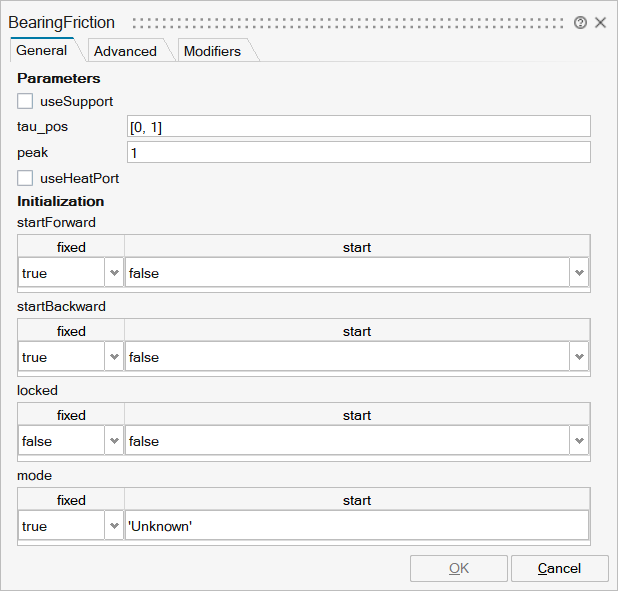BearingFriction
Coulomb friction in bearings
![]()
Library
Modelica/Mechanics/Rotational/Components
Description
This element describes Coulomb friction in bearings,i.e., a frictional torque acting between a flange and the housing.The positive sliding friction torque "tau" has to be definedby table "tau_pos" as function of the absolute angular velocity "w".E.g.
w | tau---+----- 0 | 0 1 | 2 2 | 5 3 | 8
gives the following table:
tau_pos = [0, 0; 1, 2; 2, 5; 3, 8];
Currently, only linear interpolation in the table is supported.Outside of the table, extrapolation through the lasttwo table entries is used. It is assumed that the negativesliding friction force has the same characteristic with negativevalues. Friction is modelled in the following way:
When the absolute angular velocity "w" is not zero, the friction torqueis a function of w and of a constant normal force. This dependencyis defined via table tau_pos and can be determined by measurements,e.g., by driving the gear with constant velocity and measuring theneeded motor torque (= friction torque).
When the absolute angular velocity becomes zero, the elementsconnected by the friction element become stuck, i.e., the absoluteangle remains constant. In this phase the friction torque iscalculated from a torque balance due to the requirement, thatthe absolute acceleration shall be zero. The elements beginto slide when the friction torque exceeds a threshold value,called the maximum static friction torque, computed via:
maximum_static_friction = peak * sliding_friction(w=0) (peak >= 1)
This procedure is implemented in a "clean" way by state events andleads to continuous/discrete systems of equations if friction elementsare dynamically coupled which have to be solved by appropriatenumerical methods. The method is described in(see also a short sketch in UsersGuide.ModelingOfFriction):
- Otter M., Elmqvist H., and Mattsson S.E. (1999):
- Hybrid Modeling in Modelica based on the Synchronous Data Flow Principle. CACSD'99, Aug. 22.-26, Hawaii.
More precise friction models take into account the elasticity of thematerial when the two elements are "stuck", as well as other effects,like hysteresis. This has the advantage that the friction element canbe completely described by a differential equation without events. Thedrawback is that the system becomes stiff (about 10-20 times slowersimulation) and that more material constants have to be supplied whichrequires more sophisticated identification. For more details, see thefollowing references, especially (Armstrong and Canudas de Wit 1996):
- Armstrong B. (1991):
- Control of Machines with Friction. Kluwer Academic Press, Boston MA.
- Armstrong B., and Canudas de Wit C. (1996):
- Friction Modeling and Compensation. The Control Handbook, edited by W.S.Levine, CRC Press, pp. 1369-1382.
- Canudas de Wit C., Olsson H., Åström K.J., and Lischinsky P. (1995):
- A new model for control of systems with friction. IEEE Transactions on Automatic Control, Vol. 40, No. 3, pp. 419-425.
Parameters

| Name | Label | Description | Data Type | Valid Values |
|---|---|---|---|---|
mo_useSupport | useSupport | = true, if support flange enabled, otherwise implicitly grounded | Number | 0 |
mo_tau_pos | tau_pos | Positive sliding friction characteristic [N.m] as function of w [rad/s] (w>=0) | Matrix of size Mx2 | |
mo_peak | peak | Peak for maximum friction torque at w==0 (tau0_max = peak*tau_pos[1,2]) | Scalar | |
mo_useHeatPort | useHeatPort | = true, if heatPort is enabled | Number | 0 |
mo_startForward | startForward | startForward | Structure | |
mo_startForward/fixed | fixed | Cell of scalars | true | |
mo_startForward/start | start | Cell of scalars | true | |
mo_startBackward | startBackward | startBackward | Structure | |
mo_startBackward/fixed | fixed | Cell of scalars | true | |
mo_startBackward/start | start | Cell of scalars | true | |
mo_locked | locked | locked | Structure | |
mo_locked/fixed | fixed | Cell of scalars | true | |
mo_locked/start | start | Cell of scalars | true | |
mo_mode | mode | mode | Structure | |
mo_mode/fixed | fixed | Cell of scalars | true | |
mo_mode/start | start | Cell of scalars |

| Name | Label | Description | Data Type | Valid Values |
|---|---|---|---|---|
mo_w_small | w_small | Relative angular velocity near to zero if jumps due to a reinit(..) of the velocity can occur (set to low value only if such impulses can occur) | Scalar | |
mo_K_locked | K_locked | Gain driving the relative motion between the friction elements to 0 when locked. This parameter should only be non-zero when using the model with fixed-step integration | Scalar |

| Name | Label | Description | Data Type | Valid Values |
|---|---|---|---|---|
mo__nmodifiers | Number of Modifiers | Specifies the number of modifiers | Number | |
mo__modifiers | Modifiers | Add new modifier | Structure | |
mo__modifiers/varname | Variable name | Cell of strings | 'phi_support' | |
mo__modifiers/attribute | Attribute | Cell of strings | 'start' | |
mo__modifiers/value | Value |
Ports
| Name | Type | Description | IO Type | Number |
|---|---|---|---|---|
flange_a | implicit | Flange of left shaft | input | 1 |
flange_b | implicit | Flange of right shaft | output | 1 |
Port 3 | implicit | Support/housing of component | input | mo_useSupport |
Port 4 | implicit | Optional port to which dissipated losses are transported in form of heat | input | mo_useHeatPort |